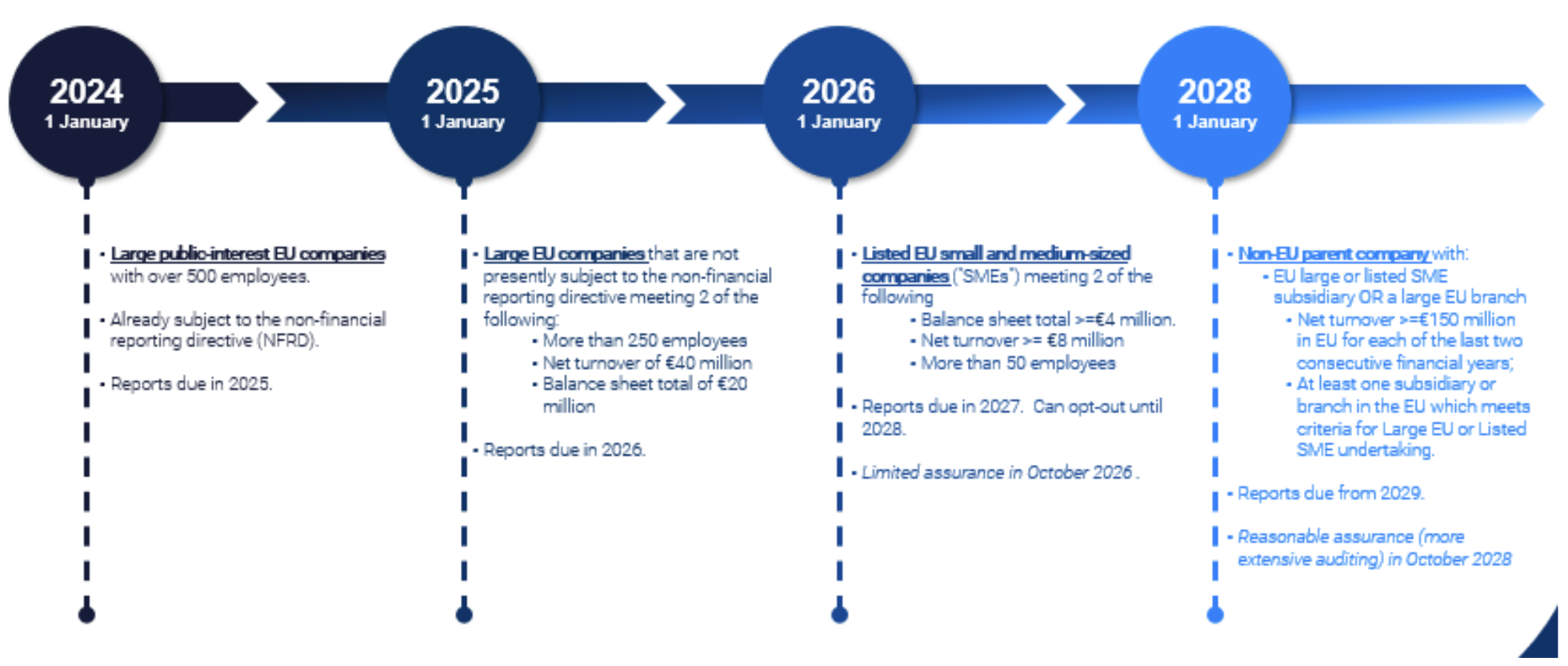Preparing for CSRD Compliance: A Comprehensive Guide for 2024
The Corporate Sustainability Reporting Directive (CSRD) replaces the European Union’s (EU’s) current Environmental, Social, and Governance (ESG) directive, the Non-Financial Reporting Directive (NFRD), and requires companies in scope to comply with the European Sustainability Reporting Standards (ESRS). CSRD compliance is critical.
To ensure your organization is well-prepared and able to provide reliable and trustworthy data covering the scope of the data points (with over 1,100 data points) needed, here are six key steps.

1. Determine the CSRD compliance and eligibility timeline
First, determine the CSRD compliance deadlines tailored to your company’s unique characteristics such as size, industry orientation, and jurisdictional parameters.
Here’s an illustrative breakdown, whether you are listed or non-listed within the EU market:

Whether your reporting is due in 2025 or later, now is the time to put plans in place to ensure compliance.
2. Familiarize yourself with the ESRS
There are 12 ESRS standards covering a range of ESG factors. Common ESRS standards will help companies manage their sustainability and disclose performance measures more efficiently. To learn more, see our on-demand webinar, Prepare for the CSRD.
Fifty percent of the requirements are environmental, 40 percent are social related, and 10 percent reflect governance. Here’s more:
- ESRS 1 (“General Requirements”) sets general principles for reporting and does not set specific disclosure requirements.
- ESRS 2 (“General Disclosures”) sets essential information to be disclosed irrespective of which sustainability issue is material to your organization. ESRS 2 is mandatory for all companies under the CSRD scope.
- Environment (E1-E5), Social (S1-S4) and Governance (G1) disclosure requirements and data points are subject to a double materiality assessment.

3. Conduct a double materiality assessment
ESRS requires companies to undertake a double materiality assessment. Companies need to understand:
- Their impacts on people and the environment (Inside–Out), and
- How social and environmental issues create financial risks and opportunities for the company (Outside-In).
Conducting a ESG Materiality Assessment lets you pinpoint paramount ESG concerns and highlights potential risks and opportunities that could arise for both your organization and stakeholders.
Document clearly how you conduct and resource the assessment and ensure you engage all internal and external stakeholders including employees, customers, investors, and communities.
4. Determine what additional ESRS standards and requirements are applicable
- Using the double materiality assessment and other organization knowledge, determine which requirements, including targets and performance measures, are relevant to your organization and the industry you serve.
- Undertake a gap analysis to identify what you already have in place, the areas for improvements, and the gaps. ESRS requirements have high levels of alignment with existing standards, frameworks, and other regulations, including EU Taxonomy, EU Whistleblowing Directive, Global Reporting Initiative (GRI), Task Force on Climate-related Financial Disclosures (TFCD), United Nations Sustainable Development Goals (UN SDGs), and International Organization for Standardization 26000 (ISO 26000). So, there is a high likelihood you already have the right policies, action plans, targets, and measures in place.
5. Develop a plan and leverage resources accordingly to close gaps
Compliance with CSRD is a multidisciplinary effort requiring cross-collaboration between various business functions.
Put a plan in place to close any gaps and ensure the plan is resourced effectively. Share your strategy and plans with teams and collaborate to ensure compliance.
ESRS requires disclosures and proof around the following:
- Strategy for managing sustainability-related material impacts, risks, and opportunities as well as governance of sustainability-related matters
- Policies, targets, actions, action plans, and resources to implement the strategy
- Performance metrics to demonstrate current achievements and progress of implementation plans and targets
6. Implement a digital solution to improve efficiency and ensure a record system
Digitalization can centrally manage all your impacts, risks, and opportunities. It can optimize how you put in place policies and track actions and action plans across your entire organization.
Digital transformation facilitates collecting, standardizing, and analyzing mass amounts of quantitative data from many disparate sources, systems, and across the value chains through integrations to support CSRD and the EU Taxonomy compliance.
Explore how an integrated digital solution with environment management, emissions management, health and safety, and metrics management can help you streamline data collection and reporting processes across the ecosystem.
Final Thoughts
CSRD will be used by investors, consumers, and policymakers. In an era where these stakeholders demand greater transparency and accountability, adhering to CSRD guidelines is both a legal requirement and an opportunity for you to demonstrate commitment to sustainable business practices.
How SAI360 Can Help
We assist organizations in overseeing their metrics and reporting via a holistic, end-to-end process and interconnected workflows. Our solutions help organizations to effectively manage metrics, oversee ESG’s performance, conduct emissions management, supervise environmental affairs, ensure health and safety, and maintain compliance across various aspects.
Learn more about CSRD from the experts via this webinar: Prepare for the Corporate Sustainability Reporting Directive, CSRD.
If you are in a hurry, download our CSRD simplified infographics.



